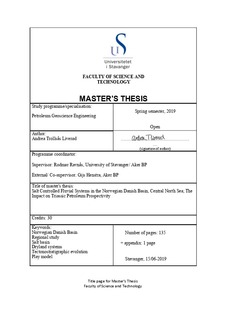| dc.contributor.advisor | Ravnås, Rodmar | |
| dc.contributor.advisor | Henstra, Gijs | |
| dc.contributor.author | Liverød, Andrea | |
| dc.coverage.spatial | The Norwegian Danish Basin | nb_NO |
| dc.date.accessioned | 2019-10-01T12:33:30Z | |
| dc.date.available | 2019-10-01T12:33:30Z | |
| dc.date.issued | 2019-06-15 | |
| dc.identifier.uri | http://hdl.handle.net/11250/2619631 | |
| dc.description | Master's thesis in Petroleum Geosciences Engineering | nb_NO |
| dc.description.abstract | The Norwegian Danish Basin is situated in the intracratonic Central North Sea. During Triassic the basin filled with thick units of syn halokinetic arid to dryland fluvial successions of the Smith Bank Formation and the Skagerrak Formation. The aim of the present study is to asses the influence of syn-depositional halokinesis on the fluvial reservoirs in order to investigate the play potential of Triassic Strata in the basin. The regional mapping and interpretations were executed using a grid of different 2D seismic surveys covering the Central North Sea area. Well data and core interpretations were applied to support lithology calibrations of to the Triassic units.
The Triassic succession was subdivided into two megasequences, the Lower Triassic Unit T1 and the Upper Triassic Unit T2. Lower Triassic Unit T1 comprises massive floodplain and playa deposits with interbedded pluvial sheet floods. The Upper Triassic Unit T2, on the other hand, comprise stacked fluvial packages were stratal architecture changes and lateral extent increases upwards.
The basin is situated on a Late Permian graben system infilled by thick Zechstein evaporites. Halokinesis was initially triggered by extension and differential loading. The initial to early basin structuring was locally restricted to the Egersund Basin area, whereas the subsequent main Middle Triassic basin-wide halokinetic structuring was located in the central parts of the basin. The final post-Triassic salt evacuation and trap-formation for the Triassic succession were related to basin margin collapse.
Potential Triassic hydrocarbons are situated in fluvial reservoirs located in structural and stratigraphic traps The traps are related to supra salt deformation or fluvial architecture pinch outs in rim synclines. A thick claystone package between the two seismic units forms the seal to Lower Triassic Unit T1 reservoir. Upper Triassic Unit T2 reservoirs are connected to Jurassic reservoirs of the Vestland Group. Hydrocarbon migrations are suggested to be from the Jurassic source rocks situated in the Central Graben or from underlying Paleozoic source rocks in the Norwegian Danish Basin. | nb_NO |
| dc.language.iso | eng | nb_NO |
| dc.publisher | University of Stavanger, Norway | nb_NO |
| dc.relation.ispartofseries | Masteroppgave/UIS-TN-IER/2019; | |
| dc.rights | Navngivelse 4.0 Internasjonal | * |
| dc.rights.uri | http://creativecommons.org/licenses/by/4.0/deed.no | * |
| dc.subject | petroleumsgeologi | nb_NO |
| dc.subject | petroleum geology | nb_NO |
| dc.title | Salt Controlled Fluvial Systems in the Norwegian Danish Basin, Central North Sea; The Impact on Triassic Petroleum Prospectivity | nb_NO |
| dc.type | Master thesis | nb_NO |
| dc.subject.nsi | VDP::Mathematics and natural science: 400::Geosciences: 450::Petroleum geology and petroleum geophysics: 464 | nb_NO |
| dc.subject.nsi | VDP::Technology: 500::Rock and petroleum disciplines: 510::Geological engineering: 513 | nb_NO |

